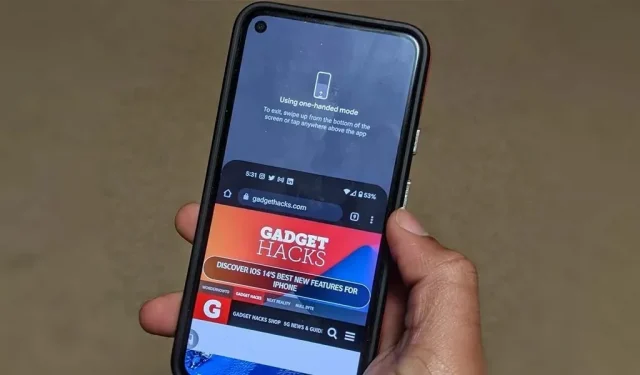For some time, Samsung, LG, and other smartphone makers have had one-handed modes that allow you to reach content on the screen with your thumb, which would otherwise be out of reach without another hand or an awkward grip. Google has finally caught up with Android 12 by releasing its own version for Pixel phones.
Apple famously included a one-handed mode called Reachability in its iPhone 6 and newer models that would slide the entire screen down to make it easier for you to reach the top half, but it wasn’t the first to offer such a feature.. Prior to this, the Samsung Galaxy Note 3 phablet had a similar accessibility option in Android 4.3 that reduced the entire screen.
These accessibility features are great for users with small hands who want more impressive performance than smartphones with larger displays. It’s even helpful for those of us with big hands who don’t want to stretch more than necessary; Pressing the button in the middle of the display is easier than pressing the button at the very top.
Although one-handed mode is now built into Google Pixel 3 and newer models with Android 12, it is not enabled by default. It may be automatically activated after updating to Android 12 on smartphones from other OEMs that did not have their own version before, but this will be different. If this applies to your device, go to step # below to learn how to use it.
Turn on one-hand control mode
Unlocking one-handed control mode for Google Pixel and other devices with stock Android 12 is easy. Phones with skinned software may work differently or exclude this feature altogether, so keep that in mind if you’re not running stock Android 12.
Go to “Settings”-> “System”-> “Gestures”-> “One-handed mode”.
Once there, turn on the “Use one-handed mode”toggle to enable the feature if it’s not already enabled.
Please note that for the one-handed shortcut to work, the Gesture Navigation feature must be enabled on your device. To make sure this is enabled, go to Settings -> System -> Gestures -> System Navigation.
Select All Screens or Notifications.
In the one-handed mode settings, there are several options for configuring this feature. The default option “Pull screen within reach”will move the screen down whenever you swipe down from the bottom edge of the screen so that the top is more accessible.
In addition, you can set the “Show notifications”mode, which will display notifications and quick settings at the top of the screen. It performs the same task as swiping down from the top of the screen with one finger, and you can still use this method at any time. However, the one-handed mode does not require you to move the phone in the palm of your hand to reach the top with your thumb.
Previous versions of the one-handed mode setting in Android 12 had “Exit when switching apps”options that would return the screen to normal when you switch to another app, and “Timeout”that let you set a duration for how long it should take. will work. accept for the screen to return to normal.
The former isn’t necessary, as you’ll still have to close the available view before switching apps. The latter has been removed, and the “Time to act”option in Accessibility Time Management does not apply to one-handed control mode.
Select accessibility option (optional)
Like many other features in Android 12, you can assign a one-handed mode to your accessibility shortcut, which can be easier to use as the swipe gesture can sometimes be finicky.
To use the accessibility shortcut, turn on the “One-handed mode shortcut”toggle. Depending on how you’ve set up the accessibility setting, you’ll see a pop-up that either reminds you how to use the on-screen accessibility button or a long press gesture on the volume buttons.
You can easily switch from one trigger to another by pressing the One-Hand Mode Shortcut. In the pop-up window, you can select “Press the accessibility button”or “Hold the volume keys”and click “Save”. You can even enable both options if you like. Selecting “More options”for the accessibility button option will take you to the accessibility button settings, where you can change the size, disappearance, and transparency of the tool.
Use one-hand control mode
Now that one-handed mode is enabled and customized to your liking, you can use it with almost any portrait-oriented app. One-handed mode will not work in landscape orientation.
Using swipe gestures
To make the top of the screen more accessible, swipe down the middle of the bottom edge of the screen. If done correctly, any content on your screen will slide down to be within the reach of your thumb. This mode can sometimes be difficult to get into, especially if there is active content where you swipe.
Whenever you choose to show notifications and quick settings in one-handed mode, swipe down the middle of the bottom edge of the screen to show them instead of dragging the current app’s screen down.
Using a shortcut
If you choose to use the one-handed mode shortcut, either tap the shortcut button on the screen or press and hold the volume up and down buttons at the same time. This will either close the app or open notifications and quick settings, depending on how you set it up.
When using the shortcut for better access to the top of the app screen, you can use the shortcut again to move the app screen up again.
If you have a notification shortcut set up, you can press the shortcut button or press and hold the volume button a second time to expand quick settings. However, using any of these shortcuts a third time won’t hide notifications and quick settings.
Also, if you’ve never used the volume button access shortcut before, you may see a prompt asking you to “Enable”the one-handed mode shortcut, which is required to continue.


